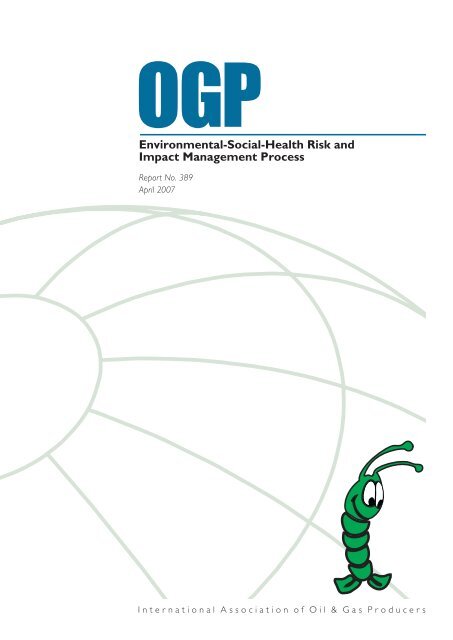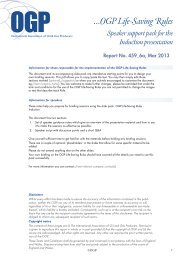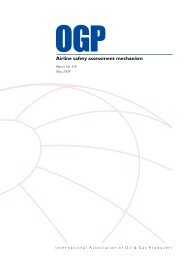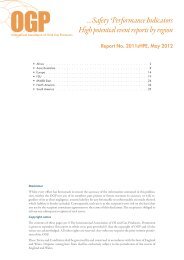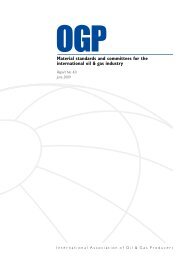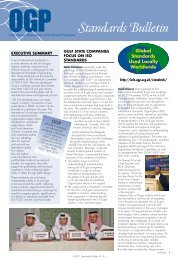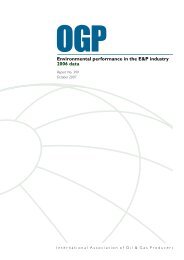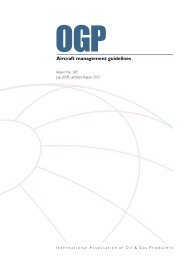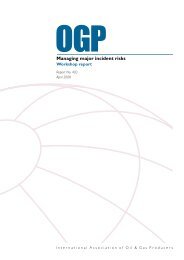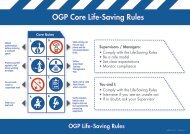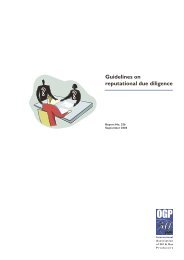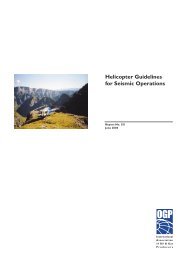Environmental-Social-Health Risk and Impact Management Process
Environmental-Social-Health Risk and Impact Management Process
Environmental-Social-Health Risk and Impact Management Process
Create successful ePaper yourself
Turn your PDF publications into a flip-book with our unique Google optimized e-Paper software.
<strong>Environmental</strong>-<strong>Social</strong>-<strong>Health</strong> <strong>Risk</strong> <strong>and</strong><br />
<strong>Impact</strong> <strong>Management</strong> <strong>Process</strong><br />
Report No. 389<br />
April 2007<br />
I n t e r n a t i o n a l A s s o c i a t i o n o f O i l & G a s P r o d u c e r s
P ublications<br />
Global experience<br />
The International Association of Oil & Gas Producers has access to a wealth of technical<br />
knowledge <strong>and</strong> experience with its members operating around the world in many different<br />
terrains. We collate <strong>and</strong> distil this valuable knowledge for the industry to use as guidelines<br />
for good practice by individual members.<br />
Consistent high quality database <strong>and</strong> guidelines<br />
Our overall aim is to ensure a consistent approach to training, management <strong>and</strong> best practice<br />
throughout the world.<br />
The oil <strong>and</strong> gas exploration <strong>and</strong> production industry recognises the need to develop consistent<br />
databases <strong>and</strong> records in certain fields. The OGP’s members are encouraged to use the<br />
guidelines as a starting point for their operations or to supplement their own policies <strong>and</strong><br />
regulations which may apply locally.<br />
Internationally recognised source of industry information<br />
Many of our guidelines have been recognised <strong>and</strong> used by international authorities <strong>and</strong><br />
safety <strong>and</strong> environmental bodies. Requests come from governments <strong>and</strong> non-government<br />
organisations around the world as well as from non-member companies.<br />
Disclaimer<br />
Whilst every effort has been made to ensure the accuracy of the information contained in this publication,<br />
neither the OGP nor any of its members past present or future warrants its accuracy or will, regardless<br />
of its or their negligence, assume liability for any foreseeable or unforeseeable use made thereof, which<br />
liability is hereby excluded. Consequently, such use is at the recipient’s own risk on the basis that any use<br />
by the recipient constitutes agreement to the terms of this disclaimer. The recipient is obliged to inform<br />
any subsequent recipient of such terms.<br />
Copyright notice<br />
The contents of these pages are ©The International Association of Oil & Gas Producers 2007.<br />
All rights are reserved.
<strong>Environmental</strong>-<strong>Social</strong>-<strong>Health</strong> <strong>Risk</strong><br />
<strong>and</strong> <strong>Impact</strong> <strong>Management</strong> <strong>Process</strong><br />
Report No: 389<br />
April 2007
The <strong>Environmental</strong>-<strong>Social</strong>-<strong>Health</strong> <strong>Risk</strong> <strong>and</strong> <strong>Impact</strong> <strong>Management</strong> <strong>Process</strong> was written by:<br />
<strong>Environmental</strong>/social assessment & HSE management task force<br />
David Ord BG<br />
Robert Finney BP<br />
Claudia Gnecco BP<br />
Ben Witchalls BP<br />
Kit Armstrong Chevron<br />
Steve Dehmer Chevron<br />
Sheryl Maruca Chevron<br />
Mike, Slovacek Chevron<br />
Jim Thompson ConocoPhillips<br />
John A Viste ConocoPhillips<br />
Rodger Melton ExxonMobil<br />
Hilary Schaffer ExxonMobil<br />
Philip Tsui ExxonMobil<br />
Gordon Thom Halliburton<br />
Anthony Webster Hess<br />
Urban Kjellén Hydro<br />
Sophie Depraz IPIECA<br />
Dena Murphy Marathon<br />
John Campbell OGP<br />
Ian Sealy Schlumberger<br />
Maarten Smies Shell<br />
William Veerkamp Shell<br />
Sigurd Juel Kinn Statoil<br />
Emmanuel Garl<strong>and</strong> Total<br />
Philippe Lafay Total
Overview<br />
Vision<br />
© 2007 OGP<br />
<strong>Environmental</strong>-<strong>Social</strong>-<strong>Health</strong> <strong>Risk</strong> <strong>and</strong> <strong>Impact</strong> <strong>Management</strong> <strong>Process</strong><br />
To deliver additional value in oil & gas projects through enhanced quality, consistency <strong>and</strong> industry<br />
alignment <strong>and</strong> by integrating social, environmental <strong>and</strong> health good practice into the HSE (<strong>Health</strong>,<br />
Safety <strong>and</strong> <strong>Environmental</strong>) management system <strong>and</strong> the overall project decision-making process.<br />
Purpose <strong>and</strong> value<br />
The goal of this initiative is to assist OGP Member <strong>and</strong> Associate Member companies to deliver oil<br />
& gas projects that are integrated with the <strong>Environmental</strong>, <strong>Social</strong> <strong>and</strong> <strong>Health</strong> (ESH) appraisal process<br />
of identifying <strong>and</strong> mitigating environmental, social <strong>and</strong> health impacts.<br />
The <strong>Environmental</strong>, <strong>Social</strong> <strong>and</strong> <strong>Health</strong> <strong>Risk</strong> <strong>Impact</strong> <strong>Management</strong> <strong>Process</strong> (e-shrimp) builds on<br />
best practice <strong>and</strong> shared learning of a number of OGP member companies. As such, OGP hopes that<br />
it will enable not only its member companies but also other oil <strong>and</strong> gas companies to benefit from<br />
the experience of its member companies.<br />
e-shrimp is a flexible approach for the industry to assess <strong>and</strong> manage ESH impacts in all its project<br />
activities throughout the full field development lifecycle. The process is built on early appraisal <strong>and</strong><br />
offers the potential to inform the decision-making processes around project approval <strong>and</strong> sanction.<br />
<strong>Environmental</strong> <strong>and</strong> <strong>Social</strong> <strong>Impact</strong> Assessment (ESIA) <strong>and</strong> impact management are only fully effective<br />
when closely integrated into project design <strong>and</strong> planning. e-shrimp may unlock business value<br />
through:<br />
• Early identification of project risks or opportunities;<br />
• Linking ESIA with project decision-making;<br />
• A consistent process to aid delivery on time <strong>and</strong> on budget;<br />
• A structured framework for contract awards;<br />
• Enhancing corporate memory by the application of experience <strong>and</strong> learning; <strong>and</strong><br />
• Establishing shareholder confidence.<br />
Preface<br />
e-shrimp is a method which has been developed to assist OGP Member <strong>and</strong> Associate Member companies in their<br />
evolving efforts to identify <strong>and</strong> manage the environmental, social <strong>and</strong> health impacts associated with oil <strong>and</strong> gas<br />
projects. It has not been developed in response to any specific law, regulation or treaty, nor does this process<br />
constitute an industry st<strong>and</strong>ard. Given differing corporate views <strong>and</strong> a wide range of regulatory approaches to<br />
identifying <strong>and</strong> managing these impacts, e-shrimp can be regarded as a generic method that gives companies flexibility<br />
to address their needs in a way that is appropriate to their specific situation. The extent to which companies<br />
incorporate e-shrimp into their project design <strong>and</strong> execution procedures or business practices will vary considerably<br />
<strong>and</strong> is always at the discretion of the company.<br />
e-shrimp is intended to facilitate planning, scheduling <strong>and</strong> implementation of ESH requirements<br />
at a level that is appropriately suited to the specific project environment. It is anticipated that use<br />
of e-shrimp will help OGP members to achieve consistent <strong>and</strong> enhanced performance, leading to<br />
improved reputation for individual companies <strong>and</strong> the industry as a whole <strong>and</strong> potentially significant<br />
quality <strong>and</strong> cost benefits.<br />
e-shrimp has been aligned to be consistent with previous OGP studies on impact assessment as well<br />
as projects addressed jointly with International Petroleum Industry <strong>Environmental</strong> Conservation<br />
i
International Association of Oil & Gas Producers<br />
ii<br />
Association (IPIECA) <strong>Social</strong> <strong>Impact</strong> Assessment Working group, the OGP-IPIECA Biodiversity<br />
working group <strong>and</strong> the OGP-IPIECA <strong>Health</strong> <strong>Impact</strong> Assessment working group.<br />
In addition, this process can be adapted to all E&P projects. e-shrimp provides practical tools that<br />
enable the supply of key deliverables. For example, information is provided on when to work with<br />
external stakeholders <strong>and</strong> how this input might be integrated into the decision-making process.<br />
Likely users or recipients<br />
OGP member companies <strong>and</strong> the wider upstream industry can now share a common set of tools<br />
that can be custom fit to the user’s specific project. The approach will establish a valuable platform<br />
to define the requirements for Contractors (including consultants). It should also assist groups in<br />
the external community, including financial institutions, investors <strong>and</strong> other stakeholders (NGOs<br />
<strong>and</strong> other interest groups) in their engagement with projects.<br />
e-shrimp Toolbox<br />
e-shrimp is designed to assist E&P project managers <strong>and</strong> HSE professionals in designing <strong>and</strong> planning<br />
work programmes for projects. While every effort has been made to make e-shrimp as comprehensive<br />
as possible, there may be situations, where additional or more detailed consideration is<br />
necessary.<br />
An integral component of the toolbox is impact assessment. This identifies risks <strong>and</strong> opportunities,<br />
evaluates mitigation <strong>and</strong> proposes management options for the key stages in a project. These key<br />
phases are:<br />
1)<br />
)<br />
)<br />
)<br />
)<br />
)<br />
)<br />
)<br />
Business Case Evaluation;<br />
Identify <strong>and</strong> Appraise;<br />
Select;<br />
Define – FEED;<br />
Define – Detailed Design;<br />
Execute;<br />
Operate; <strong>and</strong><br />
Retire.<br />
These are explained in more detail in Annex 1<br />
For each project, we have defined four major management activities within the ESH appraisal process.<br />
These are:<br />
1)<br />
)<br />
)<br />
Stakeholder participation;<br />
<strong>Risk</strong>s, opportunities <strong>and</strong> assessment;<br />
<strong>Environmental</strong> <strong>Management</strong> Planning; <strong>and</strong><br />
)<br />
Implementation <strong>and</strong> Follow-up.<br />
Other activities that may require attention throughout the project lifecycle include: Staff/competence;<br />
lessons learnt; management; <strong>and</strong> applying new knowledge. Throughout the ESH appraisal<br />
process tasks are defined <strong>and</strong> a checklist is provided. Key deliverables for each stage are stated.<br />
e-shrimp presents the tasks for each ESH appraisal activity at each stage of the project. The user<br />
selects the tasks appropriate to the stage of the project.<br />
A key objective of the toolbox is to inform <strong>and</strong> advise for the project decision-gateways. This is<br />
achieved by creating a “deliverables register” that highlights tasks to be completed <strong>and</strong> ensures that<br />
the outcomes are fed forward to the decision-gateway by tracking project progress, highlighting key<br />
personnel involved (corporate memory) <strong>and</strong> eventually providing an audit trail for decisions made.<br />
© 2007 OGP
<strong>Environmental</strong>-<strong>Social</strong>-<strong>Health</strong> <strong>Risk</strong> <strong>and</strong> <strong>Impact</strong> <strong>Management</strong> <strong>Process</strong><br />
e-shrimp provides a flexible “shopping list” for the ESH appraisal process that can be applied to any<br />
project. This is an important feature as every ESIA system is distinctive to a degree <strong>and</strong> will reflect<br />
the regulatory regime <strong>and</strong> policy of a country, as well as policies of individual companies or Joint<br />
Ventures. Three examples of different ESIA legal policy systems are provided in the following section<br />
to highlight the large variations in which e-shrimp may operate.<br />
Description of ESIA systems<br />
Model 1<br />
A host government conducts a basin-wide Strategic <strong>Environmental</strong> Assessment (SEA) to cover all<br />
potential <strong>and</strong> existing uses of the area. The government will also determine the mitigation measures<br />
that might be required for particular oil <strong>and</strong> gas operations. When an operator wishes to begin an<br />
operation, the operator would analyse its projected operations in light of the SEA <strong>and</strong> develop documentation<br />
showing that the planned operations are consistent with the objectives of the SEA. If<br />
the government regulator agrees with this assessment, permission to proceed is granted. This model<br />
has the advantages of preventing repetitive data sets, providing general guidelines for operational<br />
requirements pre-project, fully addressing cumulative effects, <strong>and</strong> the operator has a much simpler<br />
task to perform.<br />
Model 2<br />
The operator develops the ESIA based on pre-Front End Engineering Design (FEED) information.<br />
The government regulatory agencies issue a permit on the basis of this assessment. Planning in the<br />
form of an environmental management plan (EMP) is undertaken based on general information<br />
about the planned operations <strong>and</strong> general knowledge of the environment. Conditional mitigation<br />
measures are defined, determined by the range of possible situations that may be encountered as<br />
project design evolves <strong>and</strong> as more detailed information about the environment becomes available.<br />
This process allows for adaptive management as detailed information about the project is defined. It<br />
calls for the EMP to be refined as necessary as more detailed design or environmental information<br />
becomes available.<br />
Model 3<br />
In many parts of the world <strong>and</strong> when international lenders are involved, detailed project design <strong>and</strong><br />
environmental information are needed before the ESIA can be completed. In this model, the ESIA<br />
process is inefficient <strong>and</strong> requires a considerable number of iterations that have to be approved by the<br />
regulator (or lender). As design changes take place, provision of ESIA addenda adds to the overall<br />
expense, without necessarily adding value to the project. This model is the most complex <strong>and</strong> costly<br />
of the three models to implement.<br />
© 2007 OGP<br />
1
International Association of Oil & Gas Producers<br />
Using the e-shrimp Toolbox<br />
1)<br />
)<br />
)<br />
)<br />
)<br />
)<br />
)<br />
Review the e-shrimp Overview document;<br />
Select the type of project;<br />
Refer to the e-shrimp Framework <strong>and</strong> select the appropriate project phase (from Preproject;<br />
Identify <strong>and</strong> Appraise; Select; Define – FEED; Define – Detailed; Execute; Operate;<br />
Retire);<br />
Identify the e-shrimp activity appropriate to the project phase (from Stakeholder engagement,<br />
analysis <strong>and</strong> communication; Issues identification <strong>and</strong> scoping; Integration <strong>and</strong> assessment;<br />
Implementation <strong>and</strong> monitoring;<br />
Behind each cell of the e-shrimp Framework, specific Task Sheets are available. You will have<br />
the option to open a Task Sheet relevant to that activity <strong>and</strong> phase. Note that in some cases,<br />
more than one Task Sheet may be available, relating to each specific task;<br />
The Task Sheet contains a description of the activity, a list of deliverables <strong>and</strong> a checklist to be<br />
used in the achievement of the deliverables. Where there are particularly significant links to<br />
other e-shrimp activities, these are identified.<br />
In addition to providing a tool-box on ESH good practice <strong>and</strong> delivery at each project phase,<br />
the e-shrimp Framework provides a means to provide project assurance that all appropriate<br />
tasks have been completed. Thus the e-shrimp Framework can be used as a checklist in its<br />
own right.<br />
© 2007 OGP
1 Business case evaluation<br />
© 2007 OGP<br />
<strong>Environmental</strong>-<strong>Social</strong>-<strong>Health</strong> <strong>Risk</strong> <strong>and</strong> <strong>Impact</strong> <strong>Management</strong> <strong>Process</strong><br />
The business case evaluation phase could include concession acquisition <strong>and</strong> country entry, <strong>and</strong> new operations in part of a country<br />
already established.<br />
Concession acquisition <strong>and</strong> country entry New operations area entry<br />
Definition Company entry into a country, where it does not<br />
have established commercial or technical<br />
activities.<br />
Typical Activities Concession acquisition <strong>and</strong> the establishment of<br />
a representative office.<br />
Support Activities • Road transport;<br />
•<br />
•<br />
•<br />
•<br />
•<br />
Air transport;<br />
Procurement;<br />
Cleaning <strong>and</strong> catering;<br />
Waste disposal; or<br />
Security.<br />
Company entry in a part of a country, in which it<br />
does not yet have established commercial or<br />
technical activities. This situation may occur<br />
when a company acquires a new concession<br />
away from its established area of operations in<br />
the country<br />
The establishment of a local office <strong>and</strong>/or a new<br />
operations base in the new area.<br />
•<br />
•<br />
•<br />
•<br />
•<br />
•<br />
•<br />
Road transport;<br />
Water transport;<br />
Air transport;<br />
Procurement;<br />
Cleaning <strong>and</strong> catering;<br />
Waste disposal; or<br />
Security.<br />
Construction activities • Dredging or earthmoving;<br />
•<br />
•<br />
Road construction; or<br />
Camp erection<br />
Business activities Determining business case prior to signing PSA.<br />
2 Identify <strong>and</strong> appraise<br />
This phase could include project proposals <strong>and</strong> also conducting a feasibility study.<br />
Project proposal<br />
•<br />
Annex 1 – Definition of project phases & activities<br />
A company proposal to acquire a concession, to carry out activities, establish new facilities or exp<strong>and</strong> or modify existing activities,<br />
operations or facilities.<br />
Business activities/facilities<br />
•<br />
•<br />
•<br />
•<br />
Seismic or other geological survey<br />
Drilling;<br />
Field development;<br />
Development drilling;<br />
•<br />
•<br />
•<br />
•<br />
[Surface] production facilities;<br />
Pipelines;<br />
Terminals <strong>and</strong> loading facilities; or<br />
Marine transport, both export <strong>and</strong> supply<br />
Exploration activity Exploration survey/exploration<br />
drilling/development drilling<br />
Support activities • Road transport;<br />
•<br />
•<br />
•<br />
•<br />
•<br />
•<br />
Water transport;<br />
Air transport;<br />
Procurement;<br />
Materials h<strong>and</strong>ling <strong>and</strong> waste,<br />
Cleaning <strong>and</strong> catering; or<br />
Security.<br />
Construction activities • Dredging or earthmoving;<br />
•<br />
•<br />
Road construction; or<br />
Camp erection<br />
•<br />
•<br />
•<br />
•<br />
•<br />
•<br />
•<br />
•<br />
•<br />
•<br />
•<br />
•<br />
•<br />
•<br />
Surface production facilities;<br />
Road transport;<br />
Water transport;<br />
Air transport;<br />
Procurement;<br />
Materials h<strong>and</strong>ling <strong>and</strong> waste,<br />
Cleaning <strong>and</strong> catering; or<br />
Security.<br />
Dredging or earthmoving;<br />
Road construction;<br />
Camp erection;<br />
Pipeline construction;<br />
Facilities construction;<br />
Camp construction; or<br />
Installation offshore.
International Association of Oil & Gas Producers<br />
Feasibility study<br />
A company study to evaluate the commercial <strong>and</strong> financial, technical feasibility of a proposed project. Typically, this would include<br />
technical aspects of health, safety <strong>and</strong> environment <strong>and</strong> social aspects, such as socio-economics, social development <strong>and</strong> community<br />
health.<br />
Considerations<br />
• Any off-site activities or operations, such as • The expected project duration <strong>and</strong> the<br />
infrastructure (roads, power,<br />
possible consequences of its conclusion, such<br />
telecommunications, waste) or off-site<br />
construction.<br />
as decommissioning <strong>and</strong> ab<strong>and</strong>onment.<br />
3 Select phase<br />
This phase could include location selection <strong>and</strong> conceptual design <strong>and</strong> basic design.<br />
Definition A company study of the<br />
suitability of a location or<br />
possible alternative locations to<br />
carry out a project;<br />
Considerations Any off-site activities or<br />
operations, such as<br />
infrastructure (roads, power,<br />
waste, telecommunications), or<br />
off-site construction.<br />
Location selection Conceptual design/planning: Basic design/planning:<br />
4 Define phase (FEED <strong>and</strong> detailed design)<br />
• The conceptual design for field<br />
development (including<br />
development drilling, surface<br />
production <strong>and</strong> processing<br />
facilities, pipelines, terminals <strong>and</strong><br />
loading facilities <strong>and</strong> marine<br />
transport if required); or<br />
• The conceptual planning of an<br />
exploration survey, an exploration<br />
drilling campaign, <strong>and</strong> a<br />
development drilling campaign.<br />
• Any off-site activities or operations,<br />
such as infrastructure (roads,<br />
power, waste,<br />
telecommunications), or off-site<br />
construction.<br />
• Decommissioning, ab<strong>and</strong>onment<br />
<strong>and</strong> removal or disposal of<br />
facilities.<br />
© 2007 OGP<br />
• The basic design basis of design,<br />
field development plan) for field<br />
development (including<br />
development drilling, surface<br />
production <strong>and</strong> processing<br />
facilities, pipelines, terminals <strong>and</strong><br />
loading facilities <strong>and</strong> marine<br />
transport if required); or<br />
• The basic planning of an<br />
exploration survey, an exploration<br />
drilling campaign, <strong>and</strong> a<br />
development drilling campaign.<br />
• Any off-site activities or operations,<br />
such as infrastructure (roads,<br />
power, waste,<br />
telecommunications), or off-site<br />
construction.<br />
• Decommissioning, ab<strong>and</strong>onment<br />
<strong>and</strong> removal or disposal of<br />
facilities.<br />
This phase could include detailed design <strong>and</strong> procurement <strong>and</strong> mobilisation, construction or execution, <strong>and</strong> commissioning <strong>and</strong><br />
demobilisation.<br />
FEED, Detailed design/planning<br />
•<br />
•<br />
•<br />
The detailed design (or full field development plan) for field development (including development drilling, surface production <strong>and</strong><br />
processing facilities, pipelines, terminals <strong>and</strong> loading facilities <strong>and</strong> marine transport if required); or<br />
The detailed planning of an exploration survey, an exploration drilling campaign, <strong>and</strong>/or a development drilling campaign.<br />
Detailed design of facilities may be part of an Engineering, Procurement <strong>and</strong> Construction (EPC) contract for project realisation.<br />
Considerations<br />
• Any off-site activities or operations, such as • Decommissioning, ab<strong>and</strong>onment <strong>and</strong><br />
infrastructure (roads, power, waste, water,<br />
telecommunications), <strong>and</strong> off-site<br />
construction.<br />
removal or disposal of facilities.<br />
Procurement <strong>and</strong> mobilisation<br />
•<br />
•<br />
The procurement of all materials for project construction or execution;<br />
The mobilisation of the construction contractor or survey or drilling contractor for the project.<br />
Considerations<br />
• Contractors’ HSE policy<br />
• Local content<br />
• Competence of staff <strong>and</strong> need for training
5 Execute phase<br />
Construction or execution<br />
•<br />
•<br />
© 2007 OGP<br />
<strong>Environmental</strong>-<strong>Social</strong>-<strong>Health</strong> <strong>Risk</strong> <strong>and</strong> <strong>Impact</strong> <strong>Management</strong> <strong>Process</strong><br />
The execution of an exploration survey or a drilling campaign; or<br />
The construction work for field development (including development drilling, surface production <strong>and</strong> processing facilities, pipelines,<br />
terminals <strong>and</strong> loading facilities).<br />
Support activities • Road transport;<br />
Construction or<br />
execution activities<br />
•<br />
•<br />
•<br />
•<br />
•<br />
•<br />
•<br />
•<br />
•<br />
•<br />
•<br />
•<br />
Commissioning & demobilisation<br />
•<br />
•<br />
Exploration survey/exploration drilling/<br />
development drilling:<br />
Water transport;<br />
Air transport;<br />
Procurement;<br />
Materials h<strong>and</strong>ling <strong>and</strong> waste;<br />
Cleaning <strong>and</strong> catering; or<br />
Security.<br />
Dredging or earthmoving;<br />
Forest clearing;<br />
Road construction; or<br />
Camp erection<br />
Drilling the well<br />
Conducting the seismic survey<br />
Construction of surface production facilities;<br />
pipelines; terminals <strong>and</strong> loading facilities;<br />
•<br />
•<br />
•<br />
•<br />
•<br />
•<br />
•<br />
•<br />
•<br />
•<br />
•<br />
•<br />
•<br />
•<br />
•<br />
Road transport;<br />
Water transport;<br />
Air transport;<br />
Procurement;<br />
Materials h<strong>and</strong>ling <strong>and</strong> waste;<br />
Cleaning <strong>and</strong> catering; or<br />
Security.<br />
Dredging or earthmoving;<br />
Forest clearing;<br />
Road construction;<br />
Camp erection;<br />
Pipeline construction;<br />
Facilities construction;<br />
Camp construction; or<br />
Installation offshore.<br />
The testing of the constructed facilities against the design specifications <strong>and</strong> their readiness for operation, their transfer from the<br />
construction contractor to the company <strong>and</strong> the start-up of operations; <strong>and</strong><br />
The demobilisation of the construction, survey or drilling contractors.<br />
Considerations<br />
• Waste management<br />
• Competence of staff <strong>and</strong> need for training<br />
6 Operate phase<br />
This phase could include operation <strong>and</strong> maintenance <strong>and</strong> expansion or modification<br />
Operation <strong>and</strong> maintenance<br />
•<br />
•<br />
Normal oil <strong>and</strong> gas production <strong>and</strong> shipping operations;<br />
Major (periodic) maintenance of production facilities, terminals <strong>and</strong> loading facilities.<br />
Considerations<br />
• <strong>Environmental</strong> management plans<br />
• Competence of staff <strong>and</strong> need for training<br />
Expansion or modification<br />
• ISO 14000<br />
•<br />
Significant changes to subsurface <strong>and</strong> surface facilities to exp<strong>and</strong> or modify oil <strong>and</strong> gas production.<br />
Considerations<br />
• Regulatory approval<br />
• <strong>Environmental</strong> management plans<br />
7 Retire phase<br />
• Competence of staff <strong>and</strong> need for training<br />
• ISO 14000<br />
This phase could include decommissioning, ab<strong>and</strong>onment <strong>and</strong> restoration activities.<br />
Decommissioning<br />
Ab<strong>and</strong>onment<br />
Restoration<br />
The termination of oil <strong>and</strong> gas production operations<br />
The removal or disposal of surface (production) facilities, pipelines <strong>and</strong><br />
terminals <strong>and</strong> loading facilities.<br />
The restoration of sites (of camps, wells, surface production facilities,<br />
pipeline rights of way, terminals <strong>and</strong> loading facilities, offices) to their<br />
original condition or to a condition for future use
International Association of Oil & Gas Producers<br />
© 2007 OGP
Stakeholder Participation<br />
•<br />
•<br />
•<br />
© 2007 OGP<br />
<strong>Environmental</strong>-<strong>Social</strong>-<strong>Health</strong> <strong>Risk</strong> <strong>and</strong> <strong>Impact</strong> <strong>Management</strong> <strong>Process</strong><br />
The engagement of stakeholders (could include: any internal or external party which has a direct or indirect interest in the project,<br />
parties which may be affected by it or parties which may wish to influence it);<br />
The analysis of stakeholder interests <strong>and</strong> influence with regard to the project <strong>and</strong> project development;<br />
Communication with stakeholders with regard to all aspects of the ESIA process.<br />
Comprises<br />
•<br />
•<br />
•<br />
information dissemination,<br />
consultation (soliciting <strong>and</strong> discussing people’s views on proposed actions) <strong>and</strong><br />
participation (a voluntary process in which stakeholders <strong>and</strong> the company come together to<br />
share,<br />
<strong>Risk</strong>s, opportunities <strong>and</strong> assessments<br />
•<br />
•<br />
The identification of subjects <strong>and</strong> issues to be addressed as part of the ESIA;<br />
The determination of the scope (terms of reference <strong>and</strong> extent) of the ESIA with regard to identified subjects <strong>and</strong> issues.<br />
Comprises<br />
•<br />
•<br />
•<br />
Assessment<br />
•<br />
•<br />
•<br />
•<br />
•<br />
•<br />
subjects <strong>and</strong> issues,<br />
potential impacts <strong>and</strong> benefits, including those based on the perceptions of stakeholders;<br />
Issue identification <strong>and</strong> scoping may provide baseline information needs.<br />
The collection of qualitative <strong>and</strong> quantitative information on the existing environmental, social (including public, community health <strong>and</strong><br />
socio-economic) conditions in <strong>and</strong> in the vicinity of the location(s), where the project will take place;<br />
Note that baseline information needs may be available from issue identification <strong>and</strong> scoping activities;<br />
The interpretation of this information in terms of the impact assessment;<br />
The identification <strong>and</strong> appraisal of the risk of potential negative impacts on <strong>and</strong> benefits for the environment <strong>and</strong> for social<br />
development as a result of the project;<br />
The identification of measures to mitigate (avoid, reduce, remedy, compensate) the risk of such negative impacts <strong>and</strong> maximise<br />
benefits;<br />
The documentation of these negative impacts <strong>and</strong> benefits <strong>and</strong> of mitigation <strong>and</strong> optimisation measures agreed in an impact<br />
assessment report <strong>and</strong> an environmental, social (including public <strong>and</strong> community health <strong>and</strong> socio-economic) management plan.<br />
Comprises<br />
•<br />
•<br />
•<br />
locations of on-site, nearby <strong>and</strong> off-site activities or operations, such as infrastructure (roads,<br />
power, telecommunications), <strong>and</strong><br />
construction;<br />
Baseline information should include information <strong>and</strong> data on other existing or planned<br />
developments in, <strong>and</strong> in the vicinity of, the location(s), where the project will take place.<br />
<strong>Environmental</strong> <strong>Management</strong> Plan<br />
•<br />
•<br />
The compilation of plans to mitigate identified negative impacts <strong>and</strong> to optimise potential benefits in the project design <strong>and</strong> planning<br />
process; <strong>and</strong><br />
Documentation of processes for environmental <strong>and</strong> social (including public, community health <strong>and</strong> socio-economic) management<br />
during project progression.<br />
Comprises<br />
• Specific steps to address each impact or significant risk of the proposed project<br />
Implementation <strong>and</strong> Follow-up<br />
•<br />
Monitoring, audit <strong>and</strong> review of the implementation of the environmental, social (including public, community health <strong>and</strong> socioeconomic)<br />
management plan <strong>and</strong> of environmental <strong>and</strong> social (including public, community health <strong>and</strong> socio-economic) management.<br />
Comprises<br />
•<br />
•<br />
•<br />
Annex 2 – Definition of e-shrimp activities<br />
Monitoring;<br />
Evaluating the effectiveness of implemented mitigation measures;<br />
Updating of EMPs.
International Association of Oil & Gas Producers<br />
Annex 3 – History of the OGP e-shrimp initiative<br />
The potential of impact assessment in unlocking value in E&P projects <strong>and</strong> the need for an enhanced<br />
tool-box for the industry has been discussed within the OGP for several years. This initiative was<br />
originated at the 00 Society of Petroleum Engineers (SPE) HSE Conference <strong>and</strong> selected by the<br />
OGP <strong>Environmental</strong> Quality Committee for its 00 - work programme.<br />
Early public consultation was identified to be essential for an efficient process <strong>and</strong> in order to garner<br />
public support for a project. Previous OGP work to develop a list of questions for <strong>Social</strong> <strong>Impact</strong><br />
Assessment has served to help practitioners <strong>and</strong> project managers consider key questions, which<br />
typically needed to be answered for <strong>Social</strong> aspects of a project. This initiative is complementary to<br />
that <strong>and</strong> provides practical tools to aid the HSE professional <strong>and</strong> project manager throughout the<br />
project lifecycle.<br />
Twelve companies have actively supported the work programme, which in 00 identified themes<br />
<strong>and</strong> sub-themes associated with the ESIA process <strong>and</strong> shared learning <strong>and</strong> best-practice around case<br />
studies at a Workshop in Semmering in November 00 . This was attended by over 0 delegates<br />
from over 0 companies including multinational <strong>and</strong> regional oil companies <strong>and</strong> service providers.<br />
The following key challenges were identified:<br />
•<br />
Establishing impact assessment within the context of a lifecycle environmental <strong>and</strong> social management<br />
process;<br />
• Starting the impact assessment early in the project cycle to aid informed decision-making;<br />
•<br />
Effective integration of impact assessment <strong>and</strong> mitigation into the engineering design process;<br />
<strong>and</strong>,<br />
• The implementation of ESIA, with delivery of commitments.<br />
In 00 , this led to the delivery of this version of e-shrimp which covers the project lifecycle <strong>and</strong><br />
which maps project activities against ESIA activities with close reference to the project business<br />
approval process. E-shrimp is a toolbox, through which an appropriate level of environmental <strong>and</strong><br />
social assessment <strong>and</strong> management can be delivered from the earliest appraisal phases of a project,<br />
through operations to field facility ab<strong>and</strong>onment <strong>and</strong> restoration.<br />
© 2007 OGP
e-SHRIMP Deliverables Register<br />
e - S H R I M P – O G P E n v i r o n m e n t a l S o c i a l & H e a l t h R i s k & I m p a c t M a n a g e m e n t P r o c e s s
e - S H R I M P – O G P E n v i r o n m e n t a l S o c i a l & H e a l t h R i s k & I m p a c t M a n a g e m e n t P r o c e s s<br />
Project description<br />
Exploration<br />
activities<br />
Oil/gas field<br />
development<br />
Market delivery:<br />
Pipelines:<br />
LNG Development:<br />
Shipping:<br />
Stakeholder<br />
participation<br />
<strong>Risk</strong>s, opportunities<br />
<strong>and</strong> assessments<br />
ESH<br />
management plan<br />
Decision<br />
gateway<br />
Major upgrades<br />
Decommissioning<br />
Implementation<br />
<strong>and</strong> follow-up<br />
Business case<br />
evaluation<br />
• Purchase service agreement: first entry<br />
into a country or region<br />
• Approximate resource base <strong>and</strong><br />
geophysical conditions known<br />
• Known supply from oil/gas field. Initial<br />
market evaluation<br />
• Define need <strong>and</strong> objectives<br />
• Major site ab<strong>and</strong>onment forseen<br />
• Stakeholder identification strategy<br />
• Communication strategy<br />
• A country <strong>and</strong> regional ESH profile<br />
report<br />
• <strong>Risk</strong> <strong>and</strong> opportunities register<br />
• Screening note<br />
• Guidance for business visitors<br />
• N/A<br />
Are the risks acceptable<br />
<strong>and</strong>/or managable?<br />
No: → re-assess/project closure<br />
Yes:<br />
A1<br />
A2<br />
A3<br />
• Improvement register<br />
• Personnel <strong>and</strong> competence checklist<br />
A4<br />
Identify <strong>and</strong><br />
appraise<br />
• Geophysical appraisal <strong>and</strong> site<br />
boundaries of likely exploration<br />
activities<br />
• Type, scale <strong>and</strong> site boundaries of likely<br />
business activities<br />
• Type, scale <strong>and</strong> site boundaries of<br />
likely business activities<br />
• Specify required changes to existing<br />
operations<br />
• Define options based on risks <strong>and</strong><br />
opportunities<br />
• Stakeholder identification plan<br />
• Communications plan<br />
• Decision support package (DSP)<br />
• Stakeholder participation report<br />
• Commitments register<br />
• Decision support package (DSP)<br />
• Updated stakeholder participation<br />
report<br />
• ESH feasability report<br />
• Staff competence checklist<br />
• N/A<br />
Is the project<br />
economically viable?<br />
No: → project closure<br />
Yes:<br />
B1<br />
B2<br />
B3<br />
• Updated improvement register<br />
• Updated personnel <strong>and</strong> competence<br />
checklist<br />
B4<br />
Select<br />
• Engineering/geological options<br />
appraisal for exploration activities<br />
• Initial project concept <strong>and</strong> pre-FEED<br />
• Initial project concept <strong>and</strong> pre-FEED<br />
• Initial project concept <strong>and</strong> pre-FEED<br />
• Select ab<strong>and</strong>onment option<br />
• Updated stakeholder identification<br />
plan<br />
• Updated communications plan<br />
• Decision support package (DSP)<br />
• Updated stakeholder participation<br />
report<br />
• Updated commitments register<br />
• Decision support package (DSP)<br />
• Updated stakeholder participation<br />
report<br />
• ESH feasability report<br />
• Staff competence checklist<br />
• N/A<br />
Is the project<br />
economically viable?<br />
No: → project closure<br />
Yes:<br />
C1<br />
C2<br />
C3<br />
• Updated improvement register<br />
• Updated personnel <strong>and</strong> competence<br />
checklist<br />
C4<br />
E P C m a y b e a w a r d e d h e r e<br />
Define<br />
(FEED)<br />
• Define activity <strong>and</strong> location<br />
• FEED<br />
• FEED<br />
• FEED around existing operations<br />
• Develop ab<strong>and</strong>onment plan<br />
• Updated stakeholder identification plan<br />
• Updated communications plan<br />
• Decision support package (DSP)<br />
• Updated stakeholder participation<br />
report<br />
• Updated commitments register<br />
• Decision support package (DSP)<br />
• Updated stakeholder participation<br />
report<br />
• Scoping report or ESIA report<br />
• Personnel & competence checklist<br />
• Preliminary ESH management plan<br />
Is the project<br />
economically viable?<br />
No: → project closure<br />
Yes:<br />
D1<br />
D2<br />
D3<br />
• Updated improvement register<br />
• Updated personnel <strong>and</strong> competence<br />
checklist<br />
D4<br />
E P C m a y b e a w a r d e d h e r e<br />
Define<br />
(detailed design)<br />
• Detailed definition of activity <strong>and</strong><br />
location<br />
• Detailed design<br />
• Detailed design<br />
• Detailed design <strong>and</strong> existing operations<br />
• Develop detailed ab<strong>and</strong>onment plan<br />
• Updated stakeholder identification plan<br />
• Updated communications plan<br />
• Decision support package (DSP)<br />
• Updated stakeholder participation<br />
report<br />
• Updated commitments register<br />
• Decision support package (DSP)<br />
• Updated stakeholder participation<br />
report<br />
• Addendum ESIA<br />
• Staff competence checklist<br />
• Full ESH management plan<br />
Is the project<br />
economically viable?<br />
No: → project closure/re-design<br />
Yes:<br />
E1<br />
E2<br />
E3<br />
• Updated improvement register<br />
• Updated personnel <strong>and</strong> competence<br />
checklist<br />
E4<br />
• Position <strong>and</strong> install<br />
• Build<br />
• Build infrastructure<br />
• Build into existing operation<br />
Execute Operate Retire<br />
• Dismantle; relocate; reuse; recycle<br />
• Updated stakeholder identification plan<br />
• Updated communications plan<br />
• Decision support package (DSP)<br />
• Updated stakeholder participation<br />
report<br />
• Updated commitments register<br />
• Updated risk <strong>and</strong> opportunities register<br />
• N/A<br />
Is the project<br />
economically viable?<br />
No: → re-design<br />
Yes:<br />
• Assessment reports<br />
• Updated improvement register<br />
• Updated personnel <strong>and</strong> competence<br />
checklist<br />
e-SHRIMP Deliverables Register<br />
F1<br />
F2<br />
F3<br />
F4<br />
H a n d o v e r t o o p e r a t o r<br />
• Undertake activity<br />
• Project end - h<strong>and</strong> over<br />
• Operation start<br />
• Operate site(s)<br />
• Integrate with existing operation<br />
• Manage residual site impact<br />
Normal condition/minor modifications<br />
• <strong>Environmental</strong> performance report<br />
• Update stakeholder identification plan<br />
• Update communications plan<br />
• Update stakeholder participation report<br />
• Update commitments register<br />
Major expansion/modification<br />
• Notify appropriate business managers (memo,<br />
email, etc)<br />
• restart e-SHRIMP if appropriate<br />
• Updated risk <strong>and</strong> opportunities register<br />
• N/A<br />
Does the project continue to be<br />
economically viable?<br />
No:<br />
Yes:<br />
G1<br />
G2<br />
G3<br />
• Assessment reports<br />
• Updated improvement register<br />
• Updated personnel <strong>and</strong> competence checklist<br />
G4<br />
• Appraise findings. Reinstate <strong>and</strong> leave<br />
site <strong>and</strong>/or move to field<br />
development<br />
• Follow e-SHRIMP as<br />
‘decommissioning’ project<br />
• For major projects follow e-SHRIMP as<br />
‘decommissioning’ project or<br />
h<strong>and</strong>-over site (based on zero risk or<br />
limited liability)<br />
• N/A<br />
• H<strong>and</strong>-over site (based on zero risk or<br />
limited liability)<br />
• Updated stakeholder identification<br />
plan<br />
• Updated communications plan<br />
• Decision support package (DSP)<br />
• Updated stakeholder participation<br />
report<br />
• Updated commitments register<br />
• Updated risk <strong>and</strong> opportunities<br />
register<br />
• Site reinstatement <strong>and</strong> restoration<br />
plan<br />
• Decommissioning ESIA<br />
• N/A<br />
H1<br />
H2<br />
H3<br />
• Audit reports<br />
• Updated improvement register<br />
• Updated personnel <strong>and</strong> competence<br />
checklist<br />
H4


